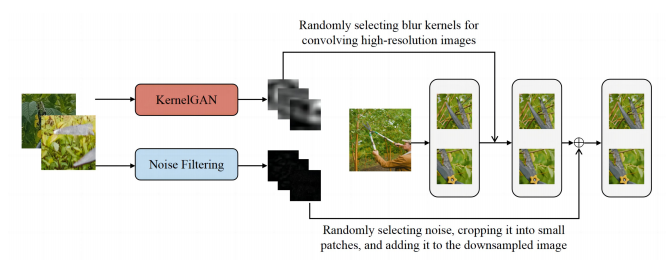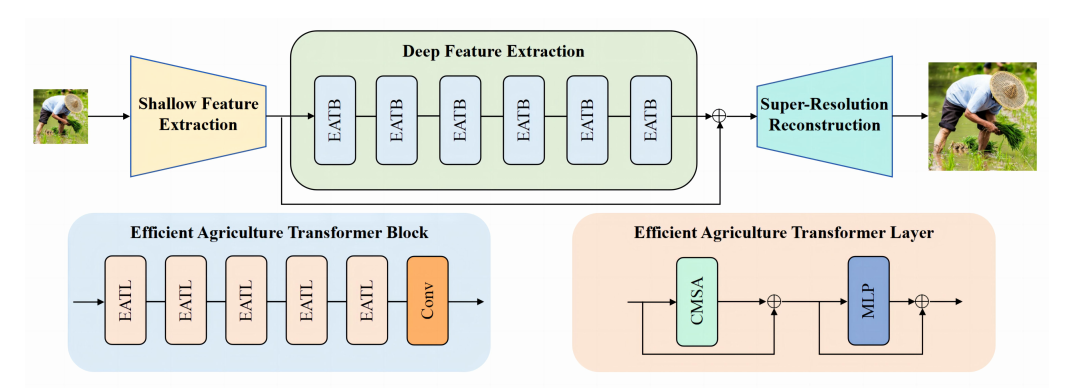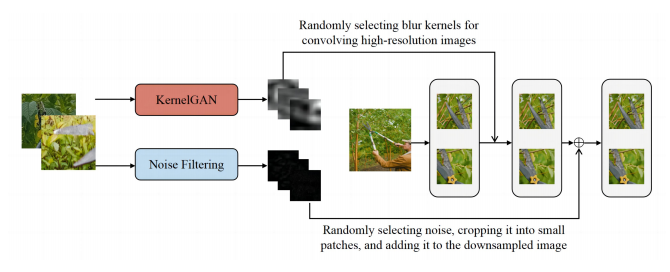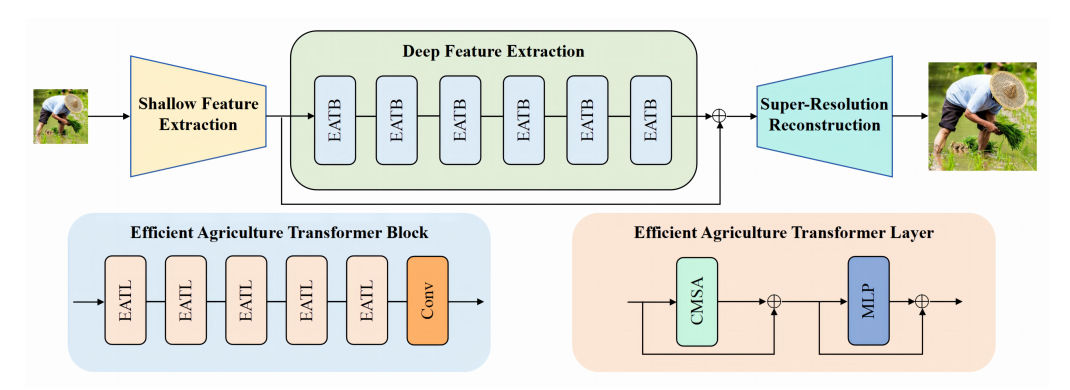Recently updated on: 2024-07-31
科研成果简介 – 中文
FarmSR:精准农业田间生产场景中的超分辨率技术
背景:
在精准农业系统中,相机网络作为不可或缺的视觉信息采集设备,然而由于成本限制和田间图像信息的复杂性,图像质量常常下降,导致低质量的视觉图像。本文提出了一种针对精准农业场景的超分辨率(SR)方法,通过设计专门的退化框架和高效的混合架构,显著提高了图像重建质量。实验结果表明,所提出的方法在主观和客观质量评估上均优于对比方法。
在农业生产中,深度学习算法与工业通信设备(如相机)的集成为捕捉农业活动、识别牲畜行为、监测作物生长、杂草识别和疾病识别提供了强大的支持。然而,由于硬件成本的限制,相机在捕捉大面积、宽角度或远距离图像时常常表现出分辨率不足的问题。此外,农业环境的多样性,包括作物类型、光照条件和背景噪声,为后续研究带来了挑战。因此,提高农业环境中低分辨率图像的质量已成为智能农业领域亟待解决的问题。
论文工作:
本文提出了一种针对精准农业场景的超分辨率算法,主要包括两个模块:退化框架和超分辨率模块。见图一和图二。退化框架通过精确估计图像退化特征和设计针对性的退化算法,生成真实的低分辨率(LR)图像用于训练。超分辨率模块则结合卷积神经网络(CNN)和Transformer的全局注意力机制,旨在提高图像重建质量的同时减少计算复杂度。实验结果表明,所提出的FarmSR方法在主观和客观质量评估上均优于对比方法。具体而言,FarmSR在多个测试集上实现了更高的峰值信噪比(PSNR)和结构相似性指数(SSIM),并且在重建图像的清晰度、自然度和层次感方面表现出色。


结论:
本文开发的混合超分辨率网络针对精准农业中的图像模糊和噪声问题,构建了一个针对实际生产场景的图像退化框架。通过结合CNN和Transformer的优势,网络能够同时关注局部和全局图像特征,实现更精细的细节和纹理恢复。实验表明,所提出的SR算法在图像重建质量上显著优于现有方法,为精准农业中的图像处理技术提供了新的视角和方法。
未来研究将继续探索SR网络在农业场景中的实际应用,包括不同作物在不同生长阶段的图像定量分析,以及网络在处理极端天气和病虫害等复杂条件下的性能研究,以满足精准农业对高效决策的需求。
[1] Chang M, Lei S*, Ru H, Yifan C, Langfang Y, Der-Jiunn D. FarmSR: Super-resolution in Precision Agriculture Field Production Scenes[C]. 2024 IEEE 22th International Conference on Industrial Informatics (INDIN), Beijing, China, 2024.
科研成果简介 – 英文
FarmSR: Super-Resolution Technology in Precision Agriculture Field Production Scenarios
Background:
In precision agriculture systems, camera networks serve as indispensable devices for visual information collection. However, due to cost limitations and the complexity of field image information, image quality often degrades, resulting in low-quality visual images. This paper presents a super-resolution (SR) method tailored for precision agriculture scenes, which significantly improves image reconstruction quality through the design of a specialized degradation framework and an efficient hybrid architecture. Experimental results show that the proposed method outperforms comparative methods in both subjective and objective quality assessments.
In agricultural production, the integration of deep learning algorithms with industrial communication devices (such as cameras) provides powerful support for capturing agricultural activities, identifying livestock behavior, monitoring crop growth, weed recognition, and disease identification. However, due to hardware cost constraints, cameras often suffer from insufficient resolution when capturing large areas, wide angles, or long-distance images. Additionally, the diversity of agricultural environments, including crop types, lighting conditions, and background noise, poses challenges for subsequent research. Therefore, improving the quality of low-resolution images in agricultural environments has become an urgent issue in the field of smart agriculture.
Paper Work:
This paper proposes a super-resolution algorithm for precision agriculture scenes, mainly comprising two modules: the degradation framework and the super-resolution module. See Figures 1 and 2. The degradation framework generates realistic low-resolution (LR) images for training by accurately estimating image degradation features and designing targeted degradation algorithms. The super-resolution module combines the local feature extraction capabilities of Convolutional Neural Networks (CNNs) with the global attention mechanism of Transformers, aiming to improve image reconstruction quality while reducing computational complexity. Experimental results show that the proposed FarmSR method outperforms comparative methods in both subjective and objective quality assessments. Specifically, FarmSR achieves higher Peak Signal-to-Noise Ratio (PSNR) and Structural Similarity Index (SSIM) on multiple test sets and excels in the clarity, naturalness, and layering of the reconstructed images.
Conclusion:
The hybrid super-resolution network developed in this paper constructs an image degradation framework for actual production scenarios in precision agriculture, addressing issues of image blur and noise. By combining the strengths of CNNs and Transformers, the network is able to focus on both local and global image features, achieving finer detail and texture restoration. Experiments demonstrate that the proposed SR algorithm significantly outperforms existing methods in terms of image reconstruction quality, providing a new perspective and method for image processing technology in precision agriculture.
Future research will continue to explore the practical application of SR networks in agricultural scenes, including quantitative analysis of different crops at various growth stages, as well as the network’s performance under complex conditions such as extreme weather and pests and diseases, to meet the demand for efficient decision-making in precision agriculture.


编辑评论 – 中文
通过超分辨率技术推进精准农业
随着我们逐步进入一个更加智能和数据驱动的时代,精准农业已成为研究和开发的关键领域。先进技术,如摄像头和深度学习算法的融合,已显著改变了农业实践,实现了更高效资源利用和作物产量的提升。然而,在现实农业环境中图像质量退化的挑战常常阻碍了这些技术的全部潜力。由Meng等人发表在知名会议上的题为《FarmSR:精准农业中的超分辨率》的最新研究,为这个问题提供了一个及时和创新的解决方案。
该论文的作者们解决了一个精准农业中的关键问题:在覆盖大面积田地、广角或远距离情况下,摄像头捕获图像的分辨率有限。这个问题在具有独特和复杂特征的农业环境中尤为严重,包括光照条件的差异、背景噪声以及作物类型的多样性。传统的图像超分辨率(SR)方法,虽然在受控实验室环境中有效,但在模拟实际田间场景的退化过程时却显得力不从心。因此,提出的FarmSR算法在弥补这一差距方面迈出了重要一步。
FarmSR方法的核心在于其定制的退化框架,该框架精确估计图像退化特征并为农业田地场景设计针对性的退化算法。通过引入新颖的实地环境模糊核和退化注入算法,作者能够生成更贴近农业环境复杂性的真实低分辨率(LR)训练图像。这种方法确保了训练出的SR模型在处理实际田地图像的独特挑战时具有鲁棒性和有效性。
FarmSR算法另一个值得注意的方面是其高效的混合架构,它结合了卷积神经网络(CNN)在局部特征提取方面的能力以及Transformers在全局依赖建模方面的优势。这种混合设计使得模型不仅能够捕捉精细的局部细节,还能理解和重建农业图像的更广泛背景,从而显著提高图像质量。
实验结果证明了FarmSR方法在现有SR算法中的优越性。无论是定量还是定性评估,FarmSR在提高精准农业环境中的图像分辨率和细节方面都取得了更好的主观和客观质量评价。这些发现不仅推进了该领域图像处理技术,还为从事相关问题的研究人员提供了宝贵的见解。
本文的贡献是多方面的。首先,它提出了一个专为精准农业场景设计的定制退化框架和退化注入算法,确保了合成LR图像的真实性和准确性。其次,所提出的混合SR网络集成了CNN和Transformers的优势,实现了农业图像的高精度SR重建。最后,实验结果清晰地证明了所提方法的有效性,为未来的研究奠定了坚实的基础。
总之,FarmSR算法在将超分辨率技术应用于精准农业方面代表了一个重大进步。它为实际田间环境中常见的图像质量退化问题提供了一个实用的解决方案,使得农业实践中的决策更加准确和高效。当我们继续探索深度学习和计算机视觉在农业中的潜力时,像这样的研究作为有价值的路标,正在推动精准农业可能性的边界。我强烈推荐这篇论文给该领域的研究人员和从业者,因为它展示了一个可能颠覆我们认识和经营农业景观方式的富有前景的方法。
编辑评论 – 英文
Editorial: Advancing Precision Agriculture through Super-Resolution Techniques
As we progress towards a more intelligent and data-driven era, precision agriculture has emerged as a pivotal area of research and development. The integration of advanced technologies, such as cameras and deep learning algorithms, has significantly transformed farming practices, enabling more efficient resource utilization and enhanced crop yields. However, the challenge of image quality degradation in real-world agricultural environments often hinders the full potential of these technologies. The recent study by Meng et al., titled “FarmSR: Super-resolution in Precision Agriculture,” published in a reputable conference, offers a timely and innovative solution to this problem.
The authors of this paper address a critical issue in precision agriculture: the limited resolution of cameras capturing images over large fields, wide angles, or long distances. This issue is exacerbated by the unique and complex characteristics of agricultural environments, including variations in lighting conditions, background noise, and the diversity of crop types. Traditional image super-resolution (SR) methods, while effective under controlled laboratory settings, struggle to accurately simulate the actual degradation processes in real-field scenarios. The proposed FarmSR algorithm, therefore, represents a significant step forward in bridging this gap.
The core of the FarmSR method lies in its tailored degradation framework, which precisely estimates image degradation features and designs targeted degradation algorithms for agricultural field scenes. By introducing a novel real-field environment blur kernel and degradation injection algorithm, the authors are able to generate realistic low-resolution (LR) training images that better mimic the complexities of agricultural environments. This approach ensures that the trained SR model is robust and effective in handling the unique challenges of real-field images.
Another notable aspect of the FarmSR algorithm is its efficient hybrid architecture, which combines the local feature extraction capabilities of convolutional neural networks (CNNs ) with the global dependency modeling prowess of Transformers. This hybrid design enables the model to not only capture fine local details but also understand and reconstruct the broader context of agricultural images, leading to significantly improved image quality.
Experimental results demonstrate the superiority of the FarmSR method over existing SR algorithms. Both quantitative and qualitative evaluations show that FarmSR achieves better subjective and objective quality assessments, indicating its effectiveness in enhancing image resolution and details in precision agriculture settings. These findings not only advance image processing technology in this field but also provide valuable insights for researchers working on related problems.
The contributions of this paper are multifaceted. Firstly, it presents a tailored degradation framework and degradation injection algorithm specifically designed for precision agriculture scenes, ensuring the authenticity and accuracy of the synthesized LR images. Secondly, the proposed hybrid SR network integrates the strengths of CNNs and Transformers, achieving high-precision SR reconstruction of agricultural images. Finally, the experimental results clearly demonstrate the effectiveness of the proposed method, providing a solid foundation for future research in this direction.
In conclusion, the FarmSR algorithm represents a significant advancement in the application of super-resolution techniques to precision agriculture. It offers a practical solution to the common problem of image quality degradation in real-field environments, enabling more accurate and efficient decision-making in farming practices. As we continue to explore the potential of deep learning and computer vision in agriculture, studies like this one serve as valuable guideposts, pushing the boundaries of what is possible in precision agriculture. I highly recommend this paper to researchers and practitioners in the field, as it presents a promising approach that could revolutionize the way we perceive and manage our agricultural landscapes.